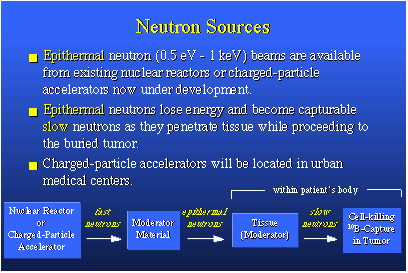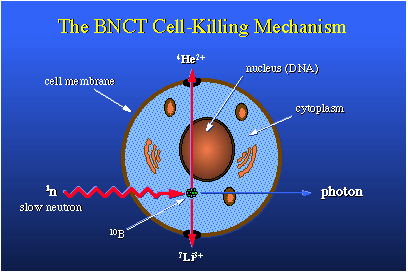|
|
Email: mfh@chem.ucla.edu |
Of course, this is what we want to happen. This is an idealized case in which we have a typical cell. Here's the nucleus with DNA, and we'd really like to damage that DNA by ionization tracking. To do so would kill the cell outright. Let's just place a boron-10 nucleus at this point. A slow neutron diffuses in, becomes captured, and the BNC reaction occurs. This nucleus fissions into a helium ion, which is an alpha particle, and into a lithium-7, and these ions go opposite directions. The photon is released. But in going through the cell you see that the helium ion passes through the nucleus, which should be quite destructive to DNA inside that nucleus. Other cellular components could be damaged as well. For therapy we want to put about 109 boron-10 atoms in each and every cell we wish to kill. This amounts to about 30 micrograms of boron-10 per gram of tumor.To make all this work, you need about 1012 neutrons per square centimeter, and this means a person undergoing therapy using this method would require something like 20 to 30 minutes' exposure to a neutron source which delivers about 109 thermal neutrons per square centimeter per second. That's an easily obtainable value.BNCT is a two-component, binary, radiation therapy, which is unique. There's the neutron, which can be turned on and off, and the boron, which if employed correctly, is perfectly innocuous. The therapy is under development for treatment of glioblastoma multiform, a very deadly brain cancer. In the United States there are probably 7,000 new candidates for this therapy each year. BNC therapy also is being considered for use in lung and prostate cancers, of which there are many, many more new cases each year. The neutron of choice for the brain cancer work is an epithermal neutron. It has kinetic energy somewhat less than one kilo-electron volt, one keV. Epithermal neutron beams can come from nuclear reactors or charged particle accelerators. These particle accelerators could be set up in clinics located in urban surroundings and require the patient to venture into the countryside to utilize a nuclear reactor. 
When they emerge from their source, epithermal neutrons easily penetrate tissue and in so doing slow down and become thermal neutrons, and capturable. Here's a nuclear reactor, or charged particle accelerator, putting out fast neutrons. Fast neutrons go through a material, called a moderator, which is rich in hydrogen. It could be a tank of water. This slows down the fast neutrons to the epithermal range. If you're after a deeply buried tumor, let's say six, eight or 10 centimeters inside the skull, the tissue between the outside of the skull and the tumor itself serves as a moderating material and slows the epithermals to the slow speed required for capture. At the tumor, capture occurs and everything works. |
